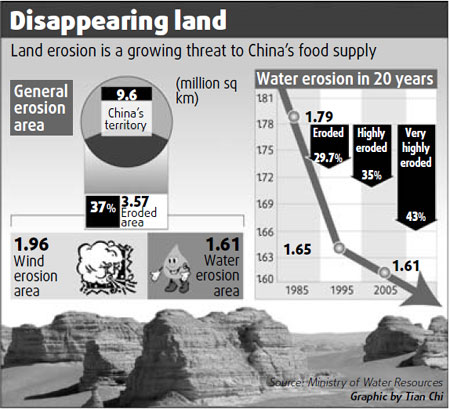
Land erosion is a growing threat to China's food supply and increasing the risk of floods, a report published on Thursday by the Ministry of Water Resources has said.
The report, which followed a three-year government survey, said China now has more than 3.5 million sq km of eroded land, of which 1.6 million sq km is due to water and 1.9 million due to wind.
About three-quarters of the country's poorest people live in areas affected by land erosion, it said.
In northeastern China, crop output could fall by as much as 40 percent over the next 50 years, if the erosion continues at its current rate.
In the southwest, over the next 35 years, about 100 million people will be at risk of losing their land, if desertification continues at the same rate.
The risk of flooding is also increasing, as rivers and lakes fill with earth from land erosion, the report said.
Between 1950 and 1999, 9.2 billion tons of soil spilled into the Yellow River, raising its bed by as much as 4 m, it said.
E Jingping, vice-minister of water resources, said on Thursday: "China has a more severe soil erosion problem than India, Japan, the United States, Australia and many other countries."
Chen Lei, minister of water resources, was quoted by Xinhua News Agency as saying that "in recent years, China has been losing 15,000 sq km of land per year to erosion".
"Economic and social development will be severely damaged if effective measures are not taken," he said.
In 2000, economic losses of a total of 200 billion yuan ($29 billion), 2.25 percent of the country's GDP, were attributed to land erosion, the report said.
In contrast, the level of investment in stopping it is too low, with just 1.63 billion yuan, 0.012 percent of GDP, spent in 2004, it said.
Sun Honglie, a member of the Chinese Academy of Sciences and part of the survey team, was quoted by Xinhua as saying that "agricultural and forestry exploitation, and highway, railway and urban construction projects are the major causes of land erosion, accounting for 78 percent of the total".
The problem of erosion is worst in hillside areas, E said.
On the Loess Plateau, for example, for each kilogram of crops produced, between 40 and 60 kg of earth is lost, he said.
China has about 200,000 sq km of hillside land, 17.5 percent of its total arable land area.
Most of it is in the upper reaches of the Yangtze River, on the Loess Plateau and in the northeast of the country.

(China Daily November 22, 2008)